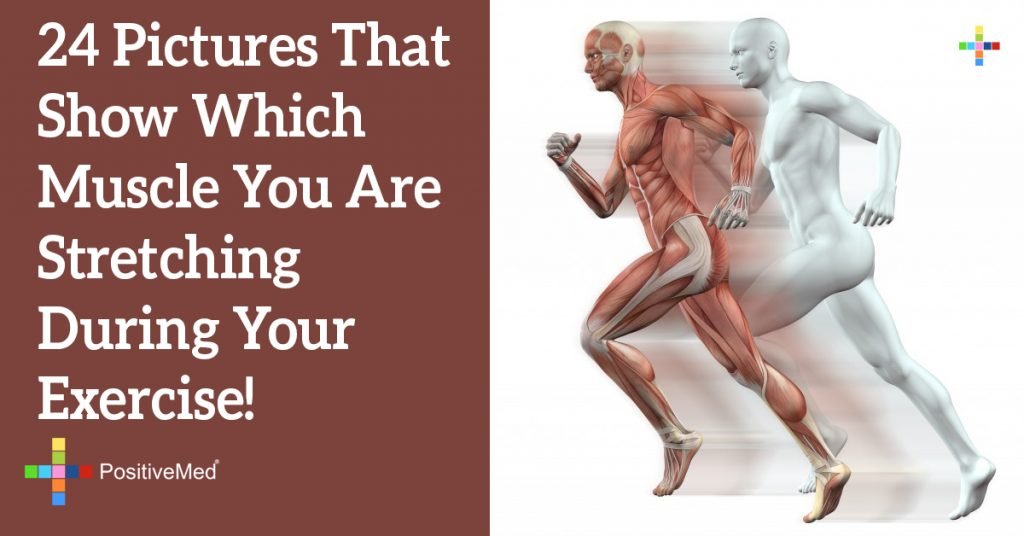
24 Pictures That Show Which Muscle You Are Stretching During Your Exercise!
[nextpage title=”…”]
Stretching is a critical part of a comprehensive exercise program; however, it often becomes the overlooked third wheel of the cardio-strength training dynamic duo. Stretching is essential for safe and effective movement and for overall health. Stretching promotes flexibility and brings nutrients and oxygen to the muscles and joints decreasing risk for injury and minimizing pain.
Though you may conjure up images of yogi’s twisted into impossible positions, stretching is actually easy to do. A program of simple, focused stretches is all you need to enhance your performance, reduce pain and even improve your posture. Here are a few important guidelines for stretching:
- Stretch when muscles are warm after cardio, a warm shower or a few minutes of dynamic movement.
- Stretch at least 2 times per week or daily if more stiff, according to the American College of Sports Medicine.
- Do not rush stretching. Hold each stretch at least 20-60 seconds.
- Do not stretch to the point of pain, you should only feel gentle tension. Back off if you feel pain or pressure in the joints.
Now you know WHY stretching is important, HOW to stretch safely, but there is one more important factor….WHAT stretches will you do?
Below are examples of versatile stretches that can become a part of your stretching routine.
1 Camel PoseStart sitting on your heels, reach your hands back for your feet and raise the hips toward the ceiling. Be careful not to hyper-extend the lower back or drop the head.
[/nextpage] [nextpage title=”…”]
2 Wide Forward FoldSit on the floor and open the legs out to the sides keeping the toes and knees pointing up. Keep the back straight and lean forward.

3 Frog PoseSit on your heels and place your hands on the floor in front of you. Open your knees to the side and slowly bring your hips down toward the ground.
4 Wide Side Lunge PoseStart standing in a wide stance and lower your hips. Bend down to one side keeping the opposite leg straight with the toes and knee pointing up.

5 ButterflySit with the bottoms of the feet touching, allow the knees to fall out to the sides. Push down with the hand or lean forward to increase the intensity of the stretch.
RELATED ARTICLE: 8 Effective Hip Stretches Your Body Will Thank You For
[/nextpage] [nextpage title=”…”]
6 Forearm Extensor StretchRaise one arm forward at shoulder height, fingers pointing down. Press down with the opposite hand or curve the fingers under to feel the stretch.

7 Lateral Side Flexion of the NeckSit or stand and elongate the spine, imagine you are dangling from a string attached to the crown of your head. Look straight ahead and slowly move the earlobe toward the shoulder, keeping shoulders down for a nice stretch on the side of the neck.
8 Neck RotationSlowly turn the head to one side while keeping the spine lengthened. Press gently with the opposite hand to increase the stretch.

9 Neck Extension StretchStand tall, lengthen the spin, and place hands on the hips with elbows pointing back. Slowly tilt head backward and avoid collapsing the cervical spine.
[/nextpage] [nextpage title=”…”]
10 Lateral Side Flexion of the Neck With AssistanceTilt the head to the side reaching the ear toward the shoulder. Use the hand to gently pull the head to facilitate a deeper stretch.

11 Half Kneeling Quad/Hip Flexor StretchKneel in the “marriage proposal” position. Start to lean forward and feel the stretch through the hip flexor. Too deepen the stretch squeeze the butt muscles or pull the foot up toward your butt.
12 Lateral Shoulder StretchReach one arm straight across the chest and press gently with the opposite hand. Avoid turning shoulders and torso, keep the body pointing straight forward.

13 Standing Assisted Neck Flexion StretchStand with the your feet together, spine long and hands behind the head. Slowly bend the knees, round the upper back and bring the elbows toward the center.
14 Lat Stretch At The WallHold onto the wall at a high position, keep the arms straight as you press the hips out away from the wall. Keep the spine lengthen and avoid rotating the torso.

[/nextpage] [nextpage title=”…”]
15 Childs PoseKneel with your knees apart and toes together. Sit your hips back onto your heels, and bring your chest toward your thighs, keep the arms lengthened and the forehead down.
16 Standing Calf StretchStand on the edge of a step and slowly lower heels to the ground. Hold onto a support if more balance is needed.

17 Front splitThis is an advanced stretch and should be done with caution. Begin in kneeling position and slowly extend the legs in opposite directions. Carefully lower the hips to the ground and keep the spine erect.
18 Seated Forward FoldSit tall with the legs extended forward. Keeping the spine long, lean forward until a stretch is felt behind the legs.

19 Single Leg Forward BendStand with one leg forward. Keep the front leg straight and shift the weight back bending the back knee and leaning forward to stretch the hamstring on the front leg.
[/nextpage] [nextpage title=”…”]
20 Deep SquatStand with your feet shoulder distance apart. Slowly lower the hips down, sit into heels and press the arms into the inner leg. Maintain a lengthened spine.

21 Seated Half King PigeonSit with the legs extended forward. Slowly pull one leg toward chest and rotate the hip out.
22 Standing Calf StretchStand in a lunge position, front knee bent and back leg straight. Reach the back heel to the ground in a slightly turned out position.

23 Lateral Flexion At The WallStand next to the wall and reach outside arm over to grab onto wall. Press hips out to the side and lean into the stretch.
24 Supine TwistLie down on your back with both legs straight. Slowly bend one knee and bring it across the body. Hold the leg with the opposite hand and keep both shoulder blades on the ground.

Allow time to notice improvements in flexibility and realize that if you do not keep a regular stretching routine, you may lose some of the benefits, such as increased range of motion or pain reduction. Stretching carefully and consistently is the key to optimal flexibility.
[/nextpage]







